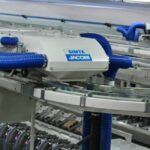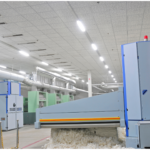A Cost-Effective Strategy For Energy Conservation In A Spinning Mill
Object
Dear Spinners, ‘Electric shock’ can instantly kill a life, while an electrical power bill slowly kills an organization. I am not focusing on how to save energy; rather, I am discussing ways to minimize electrical power waste. In this context, “savings” refers to a technical strategy, while “reducing waste” reflects a techno-commercial approach. In most cases, savings require financial resources, while minimizing waste relies on the ingenuity of the human mind!
I recommend identifying and fixing issues such as defective motors, faulty gears, leaking air compressor pipelines, incorrect cable selection,malfunctioning bearings, broken machinery, drop in efficiency, and negative work culture. For example, replacing a 21mm spindle wharve with a 19 mm can reduce the electricity bill in a ring frame, allowing us to recoup the investment within a specific period. It’s a matter of finances.
whereas, if a foreman applies more grease than required for a Ring frame, electricity bills will go up along with the wastage of grease like ‘Idli always coming with meduvada’ in Indian hotels. Second example, before purchasing an energy-efficient motor for a Ring Frame, inspect the existing motor’s accessories, belts, and overall cleanliness! We can save many lakhs in a month! In conclusion, start by reducing waste, and then focus on savings through investments. It’s my ‘Techno commercial approach‘ Is “reducing waste” focused solely on electrical waste? No, similar to family ties, every activity in a spinning mill is interconnected. With an innovative approach, anyone can begin saving right away.

Update or Download Excel sheet
Corrective actions for Rogue Accessories
For example, in a spinning mill equipped with 10,000 spindles, around 200 electrical motors of various capacities from 0.25 KW to 50.0 KW run continuously, twenty-four hours a day.
If the mill mentioned above is yours, are you certain that all motors consume the correct amount of electrical energy? Your answer is ‘no’ only! So, what next? Begin testing the motors immediately!
An electrical trainee keeping a multimeter can do an ‘Amps study’ of all motors within a few hours. Surely, we can see a minimum of 20.00 KW is wasted due to rogue motors or rogue accessories. So, by spending some thousand, you can save a minimum of one lakh rupees in a month!
Just like mentioned earlier, we can observe significant electricity wastage in the mill!
Achieving higher Efficiency and Utilization
For instance, consider a mill that produces 180,000 lakh kilograms of yarn annually, operating at an Auto Coner efficiency of 81.00%. If the mill enhances its Auto Coner efficiency by 1.00%, it could achieve annual power savings of approximately 70,000 rupees.
You reap double benefits since a strong work culture and high-quality processes are essential for enhancing production efficiency.
Like above, in the spinning department, you can get 120 Kg of more yarn over a year by reducing one idle spindle on a Ring frame. This directly reduces 3,000 rupees on your yearly electricity bill. And as a bonus, you can save an additional 18000 rupees in a year in fixed costs.
Reducing Process Waste
If you reduce hard waste by 0.10% in your mill, you can increase your annual output by 180 kg, saving 7,000 rupees on your yearly electricity bill. You know very well it applies to all types of usable waste and also!
Enhancing Utility Management
Did you know electrical power wastage in air compressors is about 35%, even in top-tier industries?
Because of unawareness, if your shift supervisor forgets to stop a motor of 15 KW in the humidification plant, you incur a loss of 600 rupees in a shift of 8.00 hours! All are money matters!!
Fine-tuning Process Parameters
A man was travelling on a bus and purchased a ticket for a specific bus stop. After a while, when the conductor returned to his seat, the man bought another ticket. A fellow passenger noticed this and asked why he had purchased two tickets. The man replied that if he happened to miss one ticket, he could manage with the other. The co-passenger, slightly annoyed, pressed him further and asked, “What if you lose both tickets?” The man smiled and replied, “I anticipated your question, my friend. I also have a monthly pass!”
Like above, Technicians in most mills are selecting and setting parameters without adequate knowledge of the process quality and the customer’s quality needs.
For instance, if you are not properly maintaining the Overhead Travelling Cleaners and failing to perform ‘Draft Zone Cleaning’ in the Simplex and Ring frames, then what is the point of sending a sample for an ‘AFIS’ test or changing the wire in a carding machine?
So, expensive process parameters are increasing the electricity bill!
If the purchase manager at a spinning mill compromises on the quality of raw materials, the technicians will incur higher costs through expensive process parameters. As a result, the mill experiences a double loss that outweighs any savings the purchase manager achieved by choosing lower-quality raw materials.
If a technician selects a TM of 4.20 in the ring frame instead of 4.10, the mill will face a minimum loss of ten lakh rupees in the annual electricity bill and thirteen lakh rupees in fixed expenses.
Investing in Energy Conservation
You possess more expertise in this area than I do, as the marketing team has given you extensive knowledge about your energy-saving equipment and its payback period. Please focus on it after you complete the above five stages.
A famous advertisement by ‘RIN’ soap claims that stains on fabric are good. I’m not sure if that’s beneficial for the cloth, but it certainly works well for ‘RIN’ soap manufacturers!
Before concluding
Why standard UKG by own instead of 40s Conversion or Comparison?
Today’s Raw material, Machinery setup, Levels of modernization, Process parameters, End products, and Utilities vary from Mill to Mill in the field. So the comparison of your mill’s UKG with other mills or converting and comparing with 40s conversion is no use at all! Even though your mill’s UKG is lesser than the other mills, still there is plenty of scope for further savings.
Standard UKG by Own
You can create an Excel sheet for arriving standard UKG for your mills and monitor the energy consumption daily. By the way, you can arrest the energy wastage instantly. This monitoring system is a micro-based approach and involves all related and non-related people together in all the time. So definitely you can save a minimum of 10.00% energy without any investments anywhere. Investments can be opted for energy saving, only if no more ways!
Kindly make use of the given ‘Excel worksheet’ for your organization
Lastly, I want to share what I learned from the inspiring Mr. Govindarajalu from Coimbatore. For him, age is just a number. At over 70 years old, he traveled across various districts and the entire state to educate numerous technicians about ‘yarn costing’ and ‘energy-saving techniques.’ He is not a consultant; he is purely a trainer. I would like to express my sincere gratitude to him, and I also thank the Managing Director of Sri Venkatalaksmi Spinners in Udumalpet for introducing him to me.




